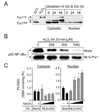Redox compartmentalization in eukaryotic cells
- PMID: 18267127
- PMCID: PMC2601570
- DOI: 10.1016/j.bbagen.2008.01.011
Redox compartmentalization in eukaryotic cells
Abstract
Diverse functions of eukaryotic cells are optimized by organization of compatible chemistries into distinct compartments defined by the structures of lipid-containing membranes, multiprotein complexes and oligomeric structures of saccharides and nucleic acids. This structural and chemical organization is coordinated, in part, through cysteine residues of proteins which undergo reversible oxidation-reduction and serve as chemical/structural transducing elements. The central thiol/disulfide redox couples, thioredoxin-1, thioredoxin-2, GSH/GSSG and cysteine/cystine (Cys/CySS), are not in equilibrium with each other and are maintained at distinct, non-equilibrium potentials in mitochondria, nuclei, the secretory pathway and the extracellular space. Mitochondria contain the most reducing compartment, have the highest rates of electron transfer and are highly sensitive to oxidation. Nuclei also have more reduced redox potentials but are relatively resistant to oxidation. The secretory pathway contains oxidative systems which introduce disulfides into proteins for export. The cytoplasm contains few metabolic oxidases and this maintains an environment for redox signaling dependent upon NADPH oxidases and NO synthases. Extracellular compartments are maintained at stable oxidizing potentials. Controlled changes in cytoplasmic GSH/GSSG redox potential are associated with functional state, varying with proliferation, differentiation and apoptosis. Variation in extracellular Cys/CySS redox potential is also associated with proliferation, cell adhesion and apoptosis. Thus, cellular redox biology is inseparable from redox compartmentalization. Further elucidation of the redox control networks within compartments will improve the mechanistic understanding of cell functions and their disruption in disease.
Figures





References
-
- Halvey PJ, Hansen JM, Lash LH, Jones DP. Compartmentation of Redox Signaling and Control: Discrimination of Oxidative Stress in Mitochondria, Cytoplasm. Nuclei and Endoplasmic Reticulum. 2007 In Press.
-
- Hansen JM, Go YM, Jones DP. Nuclear and mitochondrial compartmentation of oxidative stress and redox signaling. Annual review of pharmacology and toxicology. 2006;46:215–234. - PubMed
-
- Damdimopoulos AE, Miranda-Vizuete A, Pelto-Huikko M, Gustafsson JA, Spyrou G. Human mitochondrial thioredoxin. Involvement in mitochondrial membrane potential and cell death. The Journal of biological chemistry. 2002;277:33249–33257. - PubMed
-
- Watson WH, Pohl J, Montfort WR, Stuchlik O, Reed MS, Powis G, Jones DP. Redox potential of human thioredoxin 1 and identification of a second dithiol/disulfide motif. The Journal of biological chemistry. 2003;278:33408–33415. - PubMed
Publication types
MeSH terms
Grants and funding
LinkOut - more resources
Full Text Sources
Other Literature Sources
Molecular Biology Databases

